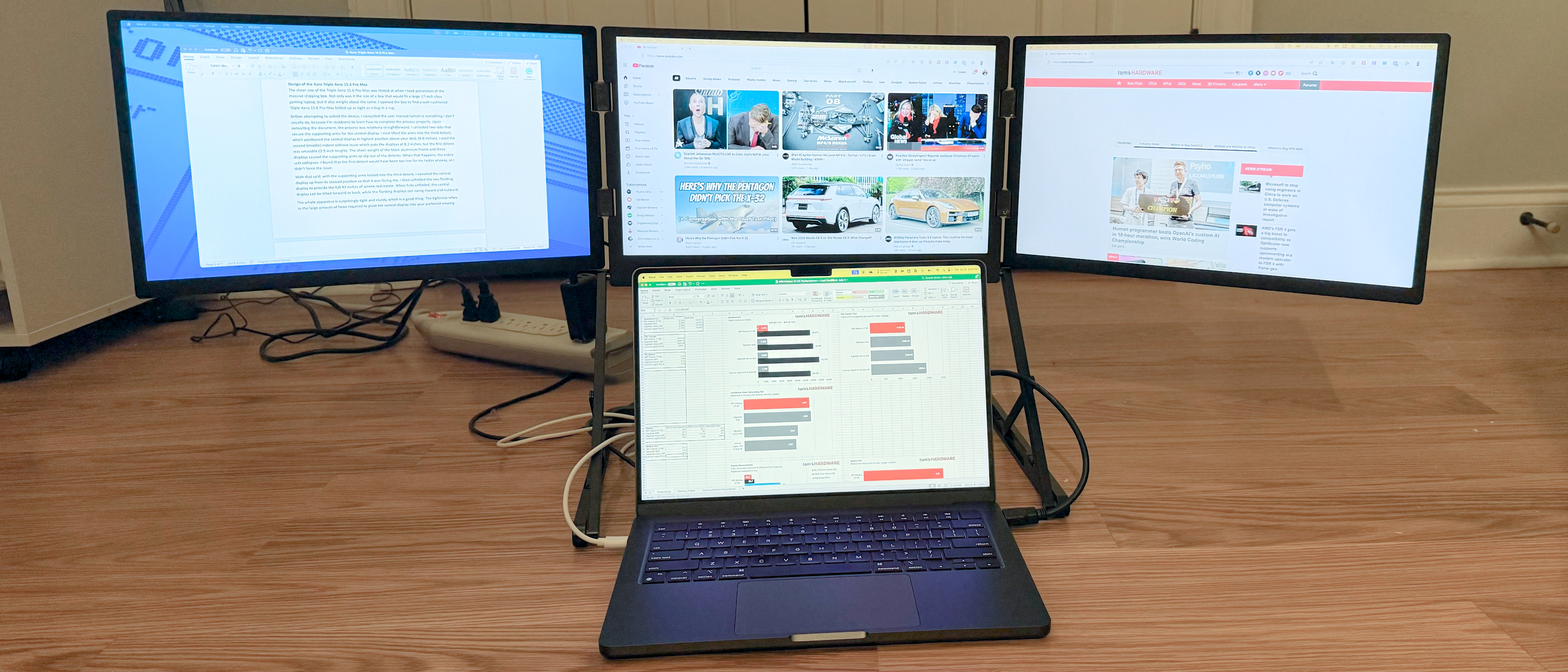Tom's Hardware Verdict
Aura’s Triple Aero 15.6 Pro Max is an exercise in excess with a 43-inch viewable area spread across three 15.6-inch 1080p displays.
Pros
- +
43-inch viewable area
- +
Sturdy aluminum frame
- +
One set of controls to configure all three displays
- +
Easily adjustable
Cons
- -
The screen won’t stay locked in the lowest height position
- -
Expensive
- -
Real-world brightness doesn’t match the manufacturer’s claim
Why you can trust Tom's Hardware
We’ve covered the best portable monitors here on Tom’s Hardware for a while, and it’s hard not to be impressed with the gains that've been made in a few short years regarding availability, quality, and pricing. We’ve seen an explosion in low-cost monitors, with many now available for under $100 (and even under $50). The overall build quality and image quality of currently available monitors are remarkable.
With so many products vying for your attention, it’s hard to stand out from the pack. However, the Aura is bringing out the big guns with its Triple Aero 15.6 Pro Max. We’ve reviewed several portable monitors that include “triple” in their name, but those products featured two external displays and counted your laptop’s internal display as panel number three. However, Aura includes three 15.6-inch 1080p panels, which unfurl to combine for 43 inches of total horizontal screen real estate.
It's a lot to take in, and the Triple Aero 15.6 Pro Max is undoubtedly an impressive piece of kit that stands out in this space. However, its size and weight limit its effectiveness as a true portable monitor.
Design of the Aura Triple Aero 15.6 Pro Max
The immense size of the Triple Aero 15.6 Pro Max was evident from the moment I took possession of the shipping box. Not only was it the size of a box that would fit a large 17-inch gaming laptop, but it also weighs about the same. I opened the box to find a well-cushioned Triple Aero 15.6 Pro Max folded up as tight as a bug in a rug.
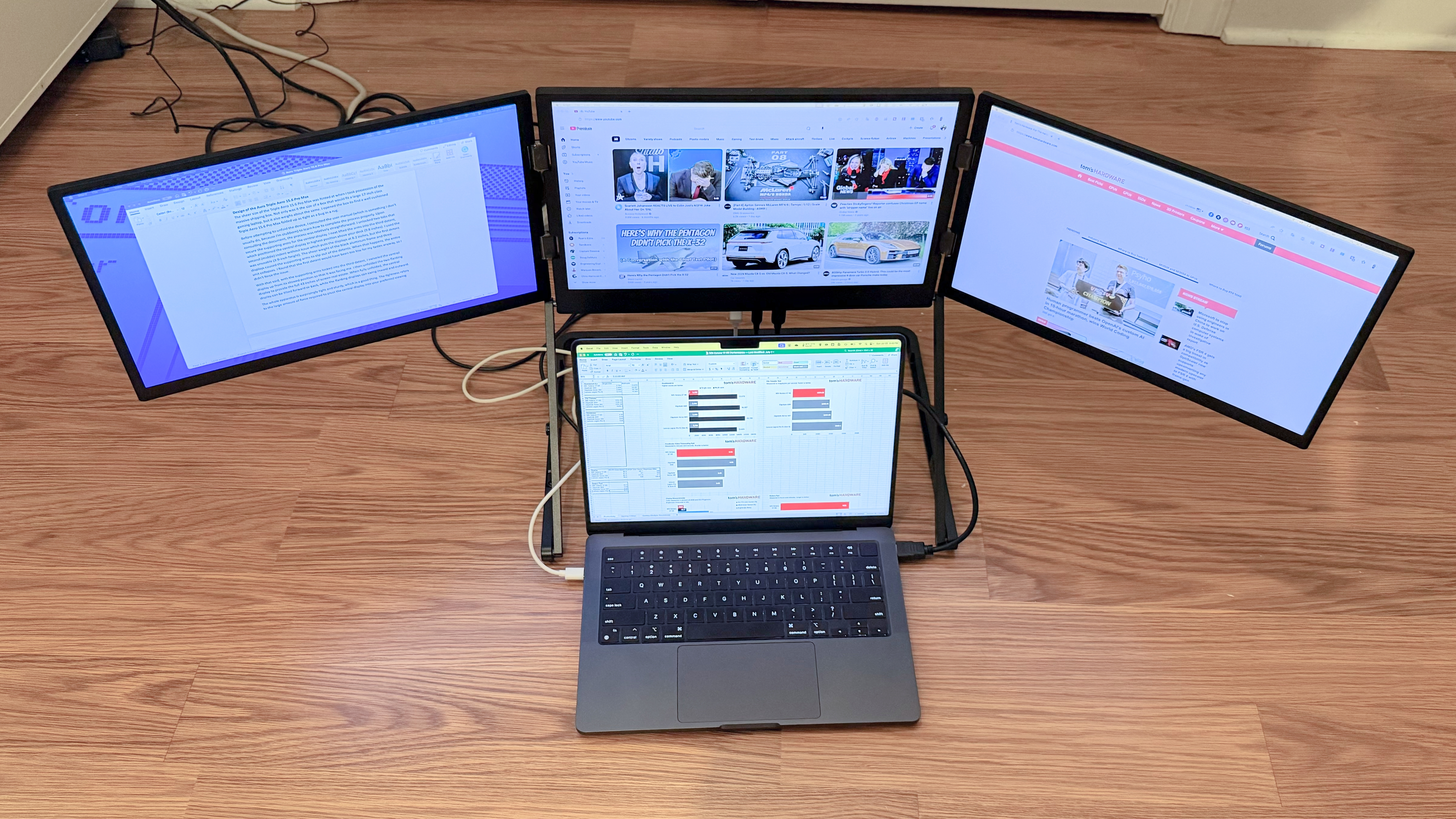
Before attempting to unfold the device, I consulted the user manual (something I don’t often do, because I’m stubborn) to learn how to complete the process correctly. Upon consulting the document, the process was relatively straightforward. I unlocked two tabs that secure the supporting arms for the central display. I next lifted the side arms into the third detent on the bottom of the chassis rails, which positions the central display in the highest position above your desk (9.8 inches). I used the second (middle) indent without issue, putting the central display at 8.2 inches, but the first detent was unusable (3.9-inch height). The weight of the black aluminum frame and three displays caused the supporting arms to slip out of the first detent. When that happens, the entire unit collapses. However, I found that the first detent would have been too low for my tastes anyway, so I didn’t force the issue.
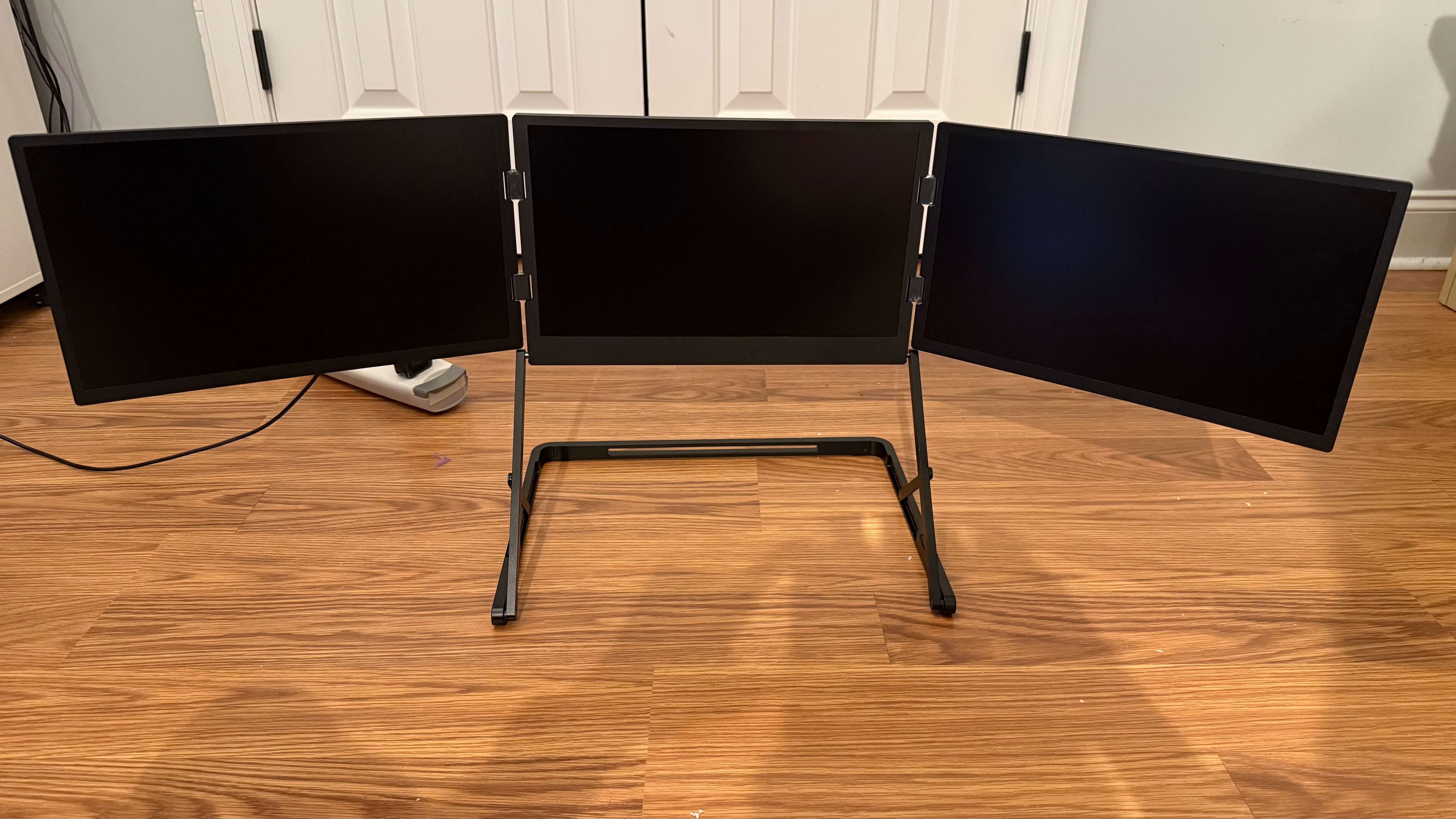
With that said, with the supporting arms locked into the third detent, I swiveled the central display up from its stowed position so that it was facing me. I then unfolded the two flanking displays to provide the full 43 inches of screen real estate. When unfolded, the central display can be tilted forward or back, while the flanking displays can swing inward and outward.
The entire apparatus is surprisingly tight and sturdy, which is a welcome feature. The tightness refers to the large amount of force required to pivot the central display to your preferred viewing angle. The sturdiness is afforded by the all-metal construction, which contributed to the considerable weight of the Triple Aero 15.6 Pro Max (7 pounds). The only disappointment was the issue with the collapsing arm while using the first detent.
Get Tom's Hardware's best news and in-depth reviews, straight to your inbox.
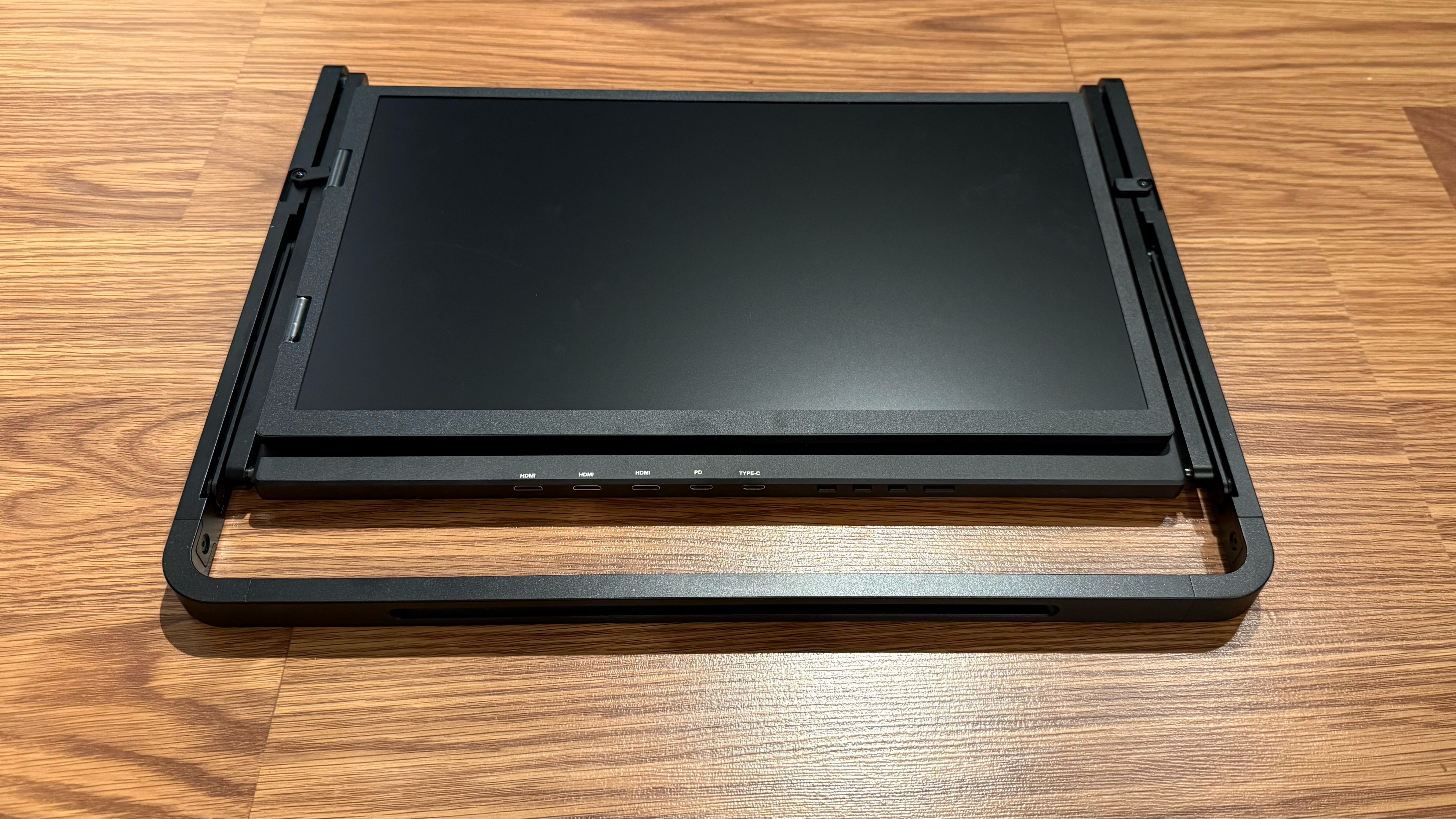
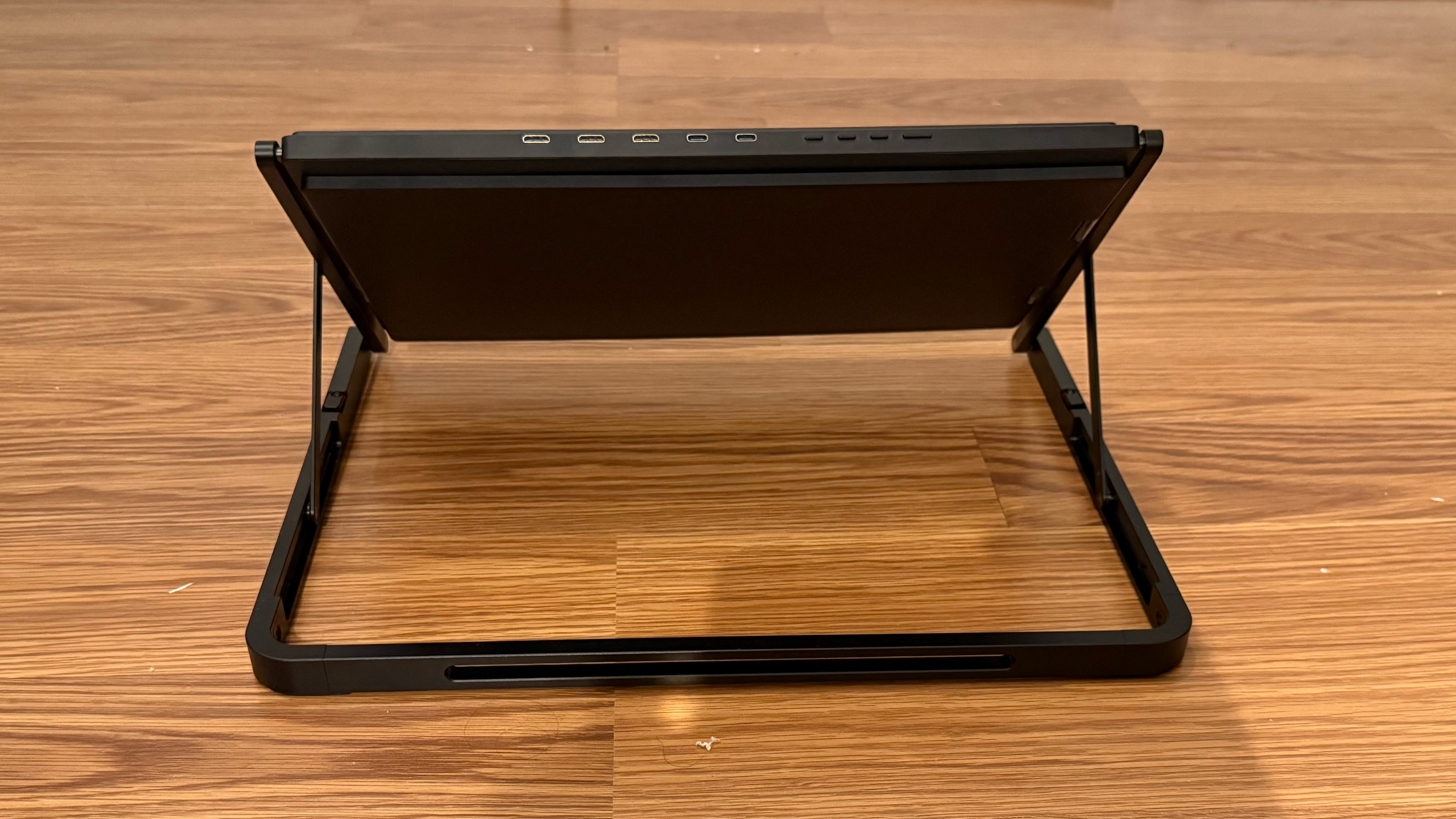
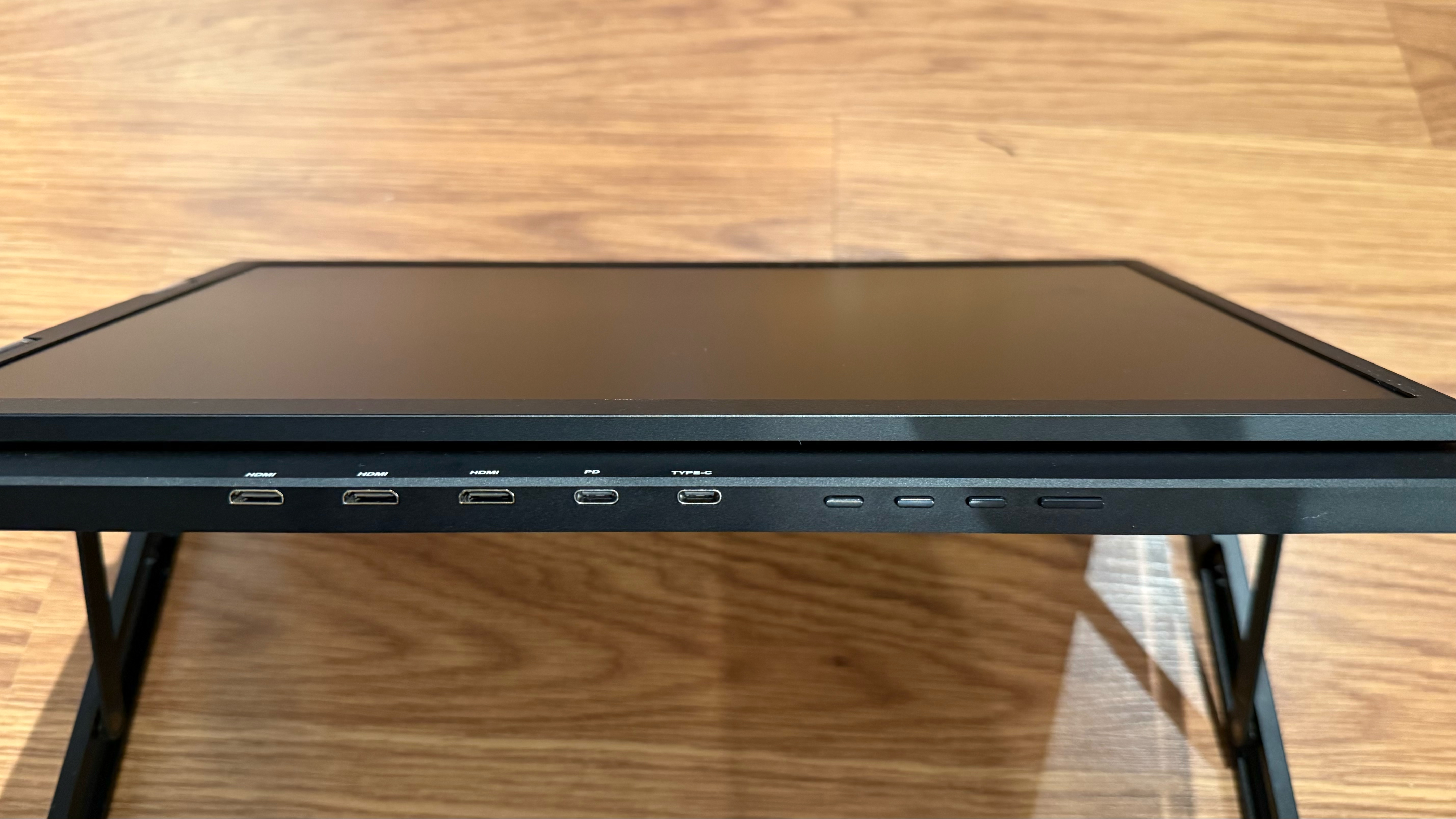
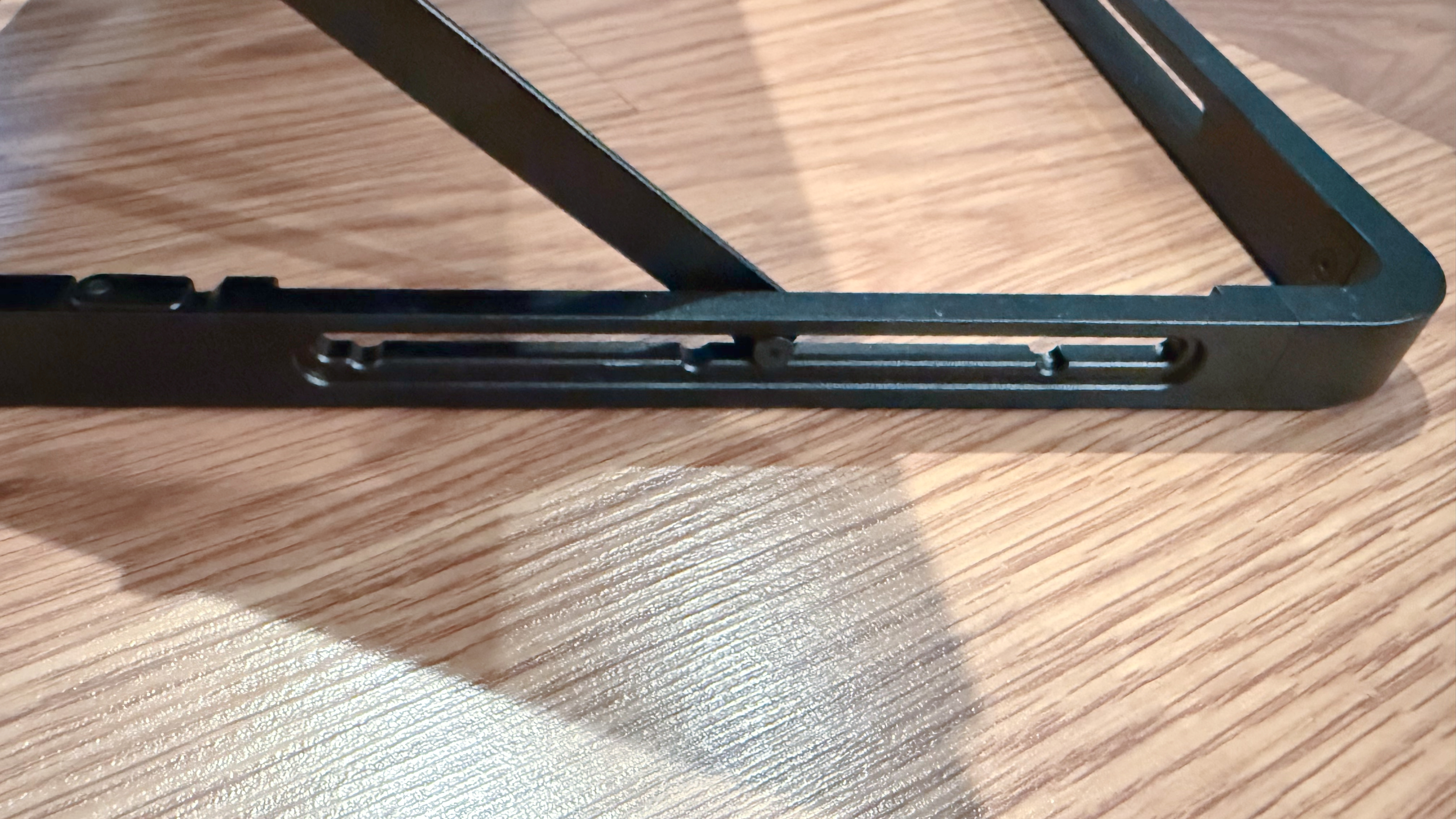
With the Triple Aero 15.6 Pro Max in its fully workable position, I was able to observe its other intricacies. There are four physical buttons: power, up, down, and menu/exit. There are also three mini-HDMI ports, one USB-C port for video, and another USB-C port for powering the Triple Aero 15.6 Pro Max. A 65-watt power adapter with two USB-C and one USB-A port is included in the box, and the monitor supports 60-watt power pass-through. The Triple Aero 15.6 Pro Max also includes two 2-watt speakers.
Aura Triple Aero 15.6 Pro Max Specifications
| Header Cell - Column 0 | Aura Triple Aero 15.6 Pro Max | KYY X90D | KYY X90A | Limink LK14 |
|---|---|---|---|---|
Panel Type / Backlight | IPS / WLED | IPS / WLED | IPS / WLED | IPS / WLED |
Number of Panels | 3 | 2 | 2 | 2 |
Screen Size / Aspect Ratio | 15.6 inches / 16:9 | 15.6 inches / 16:9 | 15.6 inches / 16:9 | 15.6 inches / 16:9 |
Max Resolution & Refresh Rate (Per Panel) | 1920 x 1080 @ 60Hz | 1920 x 1080 @ 60Hz | 1920 x 1080 @ 60Hz | 1920 x 1080 @ 60Hz |
Max Brightness | 350 nits | 300 nits | 300 nits | 400 nits |
Contrast | 1,200:1 | 1,200:1 | 1,000:1 | 1,500:1 |
Ports | 2x USB-C, 3x Mini-HDMI | 2x USB-C | 2x USB-C | 2x USB-C |
Dimensions | 14.1 x 16.5 x 1.1 inches | 11.9 x 17.3 x 3.74 inches | 11.9 x 17.3 x 3.74 inches | 13 x 7.83 x 1.4 |
Weight | 7 pounds | 3.2 pounds | 3.2 pounds | 3.3 pounds |
Price |
Connecting and Using the Aura Triple Aero 15.6 Pro Max
Before I connected the Triple Aero 15.6 Pro Max to my laptop, I once again consulted the included instruction manual to determine the required steps. At this point, I noticed that the company's website is misspelled on both the front and back of the manual. The website is listed as aura-dislays.com instead of aura-displays.com. That’s a bit tacky, but getting the correct website pulled up in my browser wasn’t exactly rocket science.
The next issue I encountered was with the drivers necessary to get this three-panel monitor to function correctly. The manual pointed me to a link to Silicon Motion’s website to download drivers for the SM76x chipset. However, typing the URL into my browser gave me a 404 error. So, I instead typed “SM76x drivers” into my search bar, which took me right to the correct download page. Since I’m testing on an Apple MacBook Pro, I downloaded the appropriate software for macOS.
In this case, the software package installed Silicon Motion’s Instant View, allowing you to easily mirror or extend multiple displays on a Mac (or Windows) system. With Instant View installed, I next began plugging in the assortment of cables.

I first used the included 65-watt wall adapter to run power to the USB-C input on the Triple Aero 15.6 Pro Max. I then ran a cable from the second USB-C port on the monitor to my MacBook Pro (M3 Pro). With this setup, only the left and central displays are activated. The right panel remained blank. So, I took the included mini-HDMI cable and plugged one end into the monitor and the other into my MacBook Pro. At that point, all three displays (four, including my MacBook Pro’s 14-inch panel) were alive.
When I first saw the overabundance of screens in front of me, I was initially overwhelmed, but quickly began my tests. The first step was to configure the displays in macOS settings to match their appearance in the real world. That meant my laptop’s internal display at the bottom, and the Triple Aero 15.6 Pro Max’s three displays positioned above. I then verified that all three displays were outputting at the specified 1920 x 1080 resolution at 60 Hz.
OSD on the Aura Triple Aero 15.6 Pro Max
The Triple Aero 15.6 Pro Max has a rather interesting on-screen display (OSD). Some multi-display portable monitors have no control buttons and no OSD, while others give you physical controls for each display panel (KYY X90D). However, the Triple Aero 15.6 Pro Max takes a different approach.

The monitor uses a single set of OSD buttons that control all three panels. Pressing the menu button once presents the OSD to control the left panel. Press the menu again, and it switches to the middle panel. Pressing it again moves to the right panel. Not only does this arrangement provide individual control for each display panel, but it also saves on manufacturing costs by not requiring two additional sets of redundant buttons.



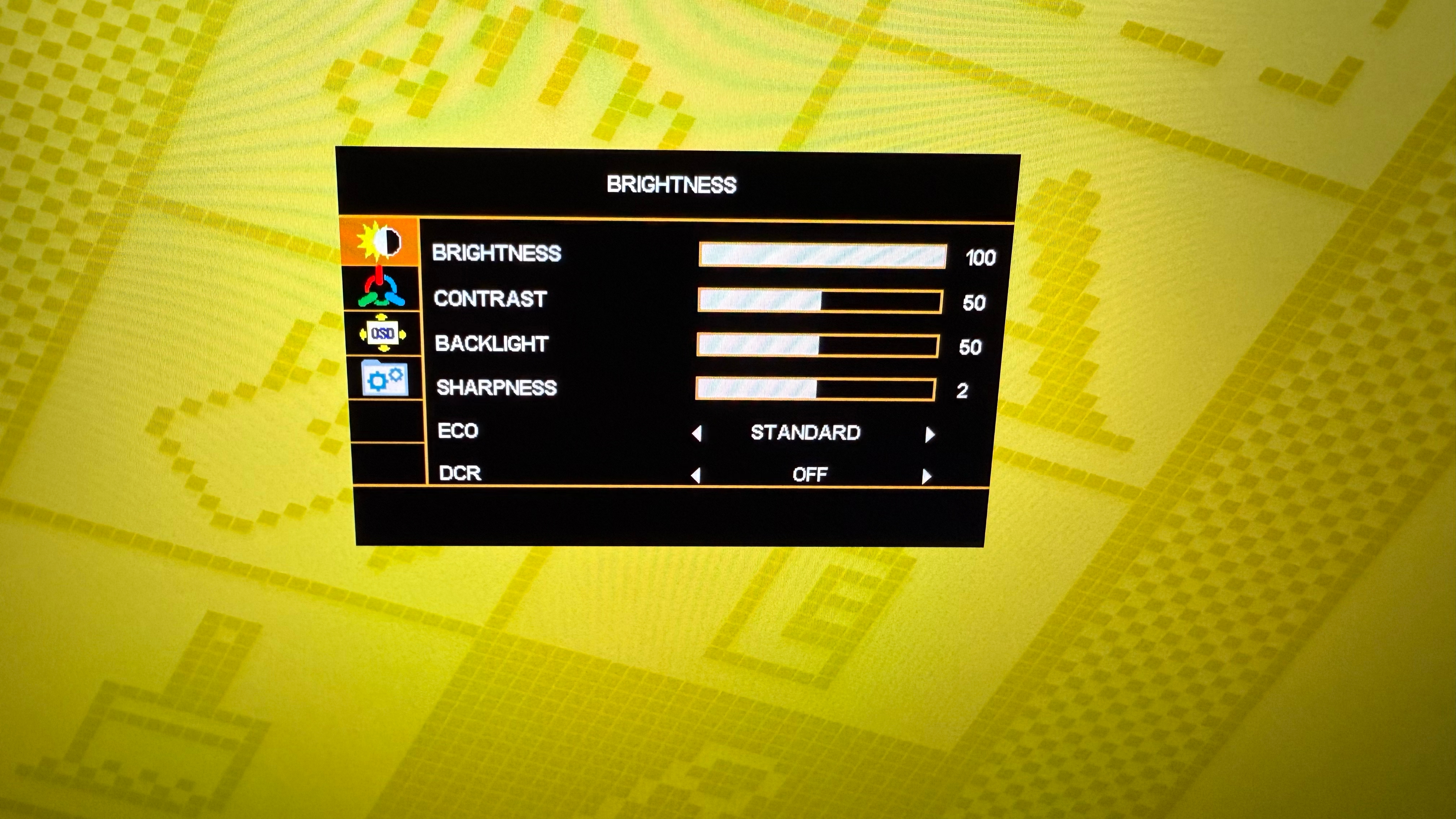
You have basic brightness, contrast, sharpness, and color controls here that you can configure per-monitor. You can also switch input sources, enable the low blue light filter, and adjust ECO modes. There’s nothing fancy about the OSD or the features it presents, but it's wholly sufficient for the productivity-focused mission of the Triple Aero 15.6 Pro Max.
Aura Triple Aero 15.6 Pro Max Display Performance
The Aura Triple Aero 15.6 Pro Max has three displays, as its name suggests. Each one is identical, offering a 15.6-inch IPS panel with a 1920 x 1080 resolution and a 60 Hz refresh rate. While some portable monitors can run at up to 360 Hz, this is a productivity-focused monitor where 60 Hz is adequate. Each display panel is also covered with an anti-reflective coating to minimize glare.
Aura talks a big game with its claimed specifications, but our testing showed some discrepancies, at least regarding maximum brightness. Aura lists the Triple Aero 15.6 Pro Max as having a maximum brightness rating of 350 nits, but our light meter measured 244 nits with brightness set to 100 percent in the OSD, which represents a 30 percent shortfall. We ran the tests multiple times and tried every combination of available picture settings to rectify the brightness issue to no avail. That’s not a good start for a portable monitor that retails for $599.
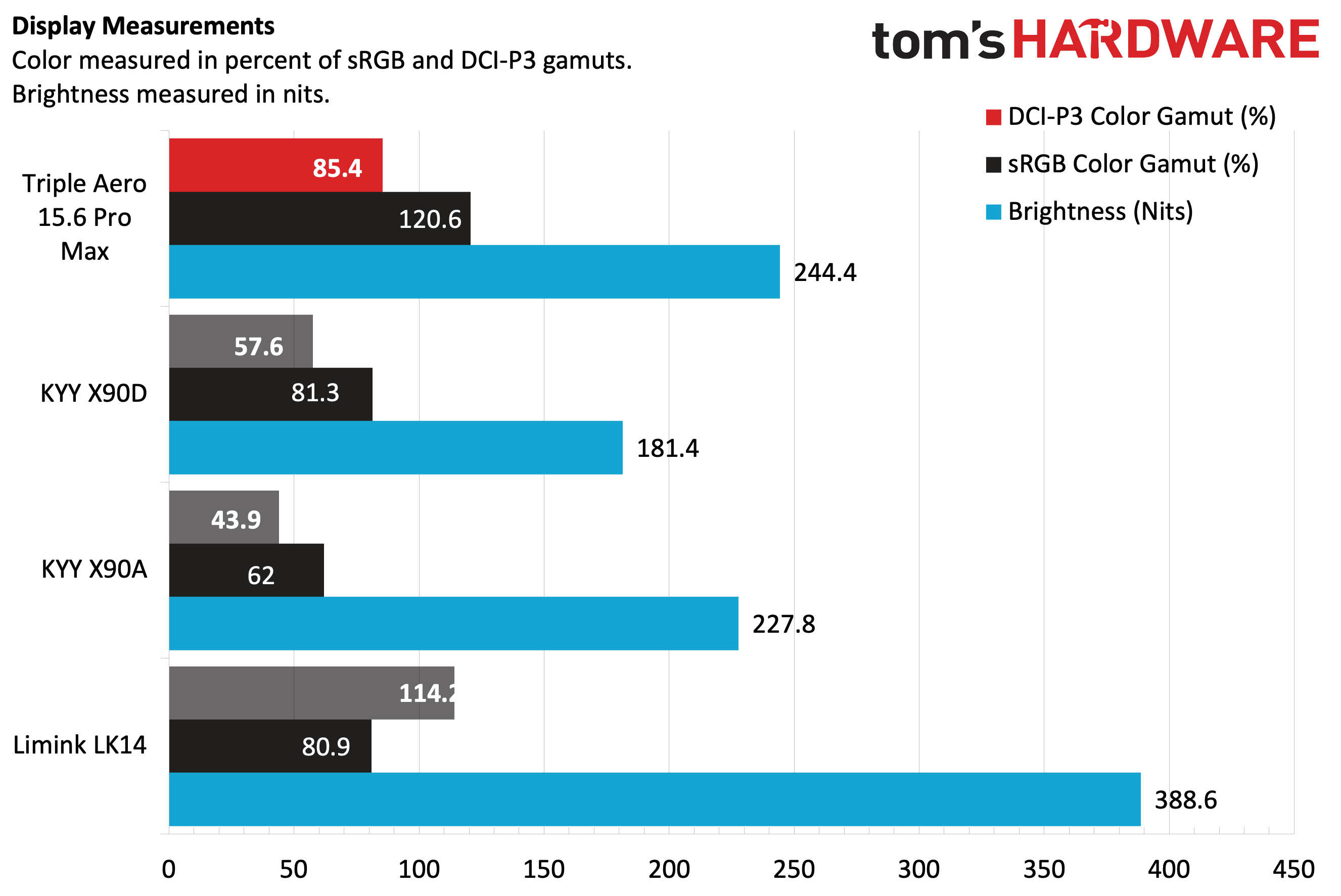
With that said, in my home environment, the brightness available with the Triple Aero 15.6 Pro Max is sufficient. I first tested the monitor downstairs in my living room, which has an overhead LED light in the ceiling fan, a couple of end table lamps, and natural light coming in from my back windows. The monitor was plenty bright in this scenario. I next moved the monitor to my home office, which is overly bright due to ten 75-watt (equivalent) LED lamps mounted on tracks. This is my typical work environment, and again, I had no complaints about the brightness.
Color performance put the Triple Aero 15.6 Pro Max near the top of the class for multi-screen portable monitors. The monitor covered 85.4% of the DCI-P3 color space and 120.6% of the sRGB color space. Those figures put it just slightly ahead of the dual-screen Limink LK14 and well ahead of the KYY K90A and K90D.
I used the Triple Aero 15.6 Pro Max for a wide variety of content, including web browsers (Microsoft Edge, Google Chrome, and Apple Safari), image editing apps (Pixelmator Pro), and productivity apps (Microsoft Word and Excel). I also spent a reasonable amount of time playing movies and TV shows on the panels, given that there’s plenty of screen real estate to go around when you’re dealing with four total displays (when counting my MacBook Pro’s internal display).
I rewatched a couple of second-season episodes of Star Wars: Andor and even watched the entirety of the classic action flick Predator on each of the three panels. The colors looked rich and accurate, as I peeked at the vibrant dresses and cloaks worn by the guests, including Mon Mothma, who danced with reckless abandon at her daughter’s wedding.
Likewise, Predator is a nearly 40-year-old movie that I enjoy watching repeatedly. I zeroed in particularly on the final battle sequence between Dutch and the Predator, which takes place at night. While the blacks didn’t look as deep as you’d find on a Mini LED or OLED panel, the Triple Aero 15.6 Pro Max performed admirably for an IPS panel during dark scenes. I watched every bone-breaking punch, with gushes of blood shooting from Dutch’s mouth as he got pummeled. I also enjoy the reds, purples, greens, and blues that appear on screen when we get the Predator’s infrared thermal vision viewpoint as he gains the upper hand.
Although it’s easy to overlook when the displays take center stage with the Triple Aero 15.6 Pro Max, it also has two 2-watt speakers. As is the case with most speakers on portable monitors, they’re good enough for playing back OS sounds or taking the occasional Google Meet/Teams/Zoom call, but they are subpar for music and movie playback. Bass is non-existent, and the overall sound output is relatively muted despite the massive footprint of the Triple Aero 15.6 Pro Max.
Bottom Line
The Aura Triple Aero 15.6 Pro Max is an impressive piece of hardware. It’s by far the largest “portable” monitor I’ve tested, given its 43-inch wingspan. That’s to be expected, as it’s also the first triple-monitor setup that has graced our labs, as we typically see dual-panel units.
The Triple Aero 15.6 Pro Max impressed with its aluminum construction, colorful panels, and a variety of ports to accommodate various laptop configurations. However, its size and weight will make many think twice about transporting this device regularly for travel purposes. While it is manageable to carry to different meeting rooms in your office, carrying this 7-pound portable monitor in addition to your laptop on a work trip is quite a burden.
There are also some performance issues, such as the shortfalls in the stated maximum brightness and what we measured in the real world. And there’s an actual physical issue with attempting to use the Triple Aero 15.6 Pro Max in its lowest height position (it doesn’t work).
With a price tag of $599, we expect near-perfection from a portable monitor, but the Triple Aero 15.6 Pro Max falls a bit short due to its flaws. However, if you absolutely must have a triple-panel option that can be stowed when not in use, it’s worth considering if you can stomach the lofty price tag. If three additional monitors is overkill for you, consider the Limink LK14 at $299 or the KYY X90D at $239.

Brandon Hill is a senior editor at Tom's Hardware. He has written about PC and Mac tech since the late 1990s with bylines at AnandTech, DailyTech, and Hot Hardware. When he is not consuming copious amounts of tech news, he can be found enjoying the NC mountains or the beach with his wife and two sons.
